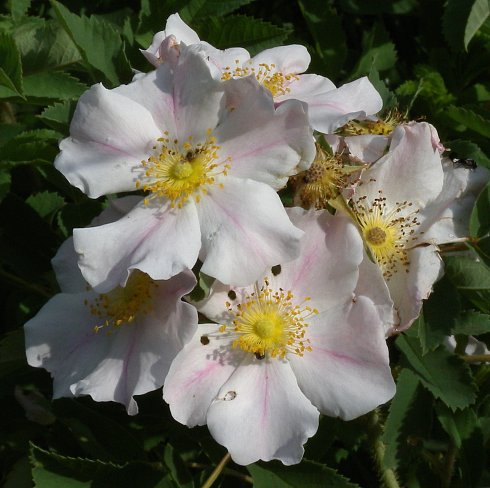
The upper surface of the leaflets is medium to dark green and glabrous, while the lower surface is light green and covered with fine short pubescence. The leaflets are either sessile or they have short petioles less than 1/8" in length. The rachises (central stalks) of the compound leaves are light green to reddish green and they are covered with short fine pubescence. The rachises are also grooved above and rounded below; fine straight prickles along their undersides may, or may not, be present. Flowers are produced from upper stems either individually or in groups of 2-4 on short corymbs (usually the latter). The flowering stalks are light green and glabrous. Each flower is 1½-2" across, consisting of 5 pink petals (rarely white), 5 green sepals, a ring of numerous stamens, a flattened cluster of short styles, and an inferior ovary that is glabrous. The petals are obovate-orbicular in shape; sometimes they are somewhat bicolored with rays of pink on a lighter background. The sepals are narrowly lanceolate and about one-half the length of the petals. The stamens and styles are more or less yellow.
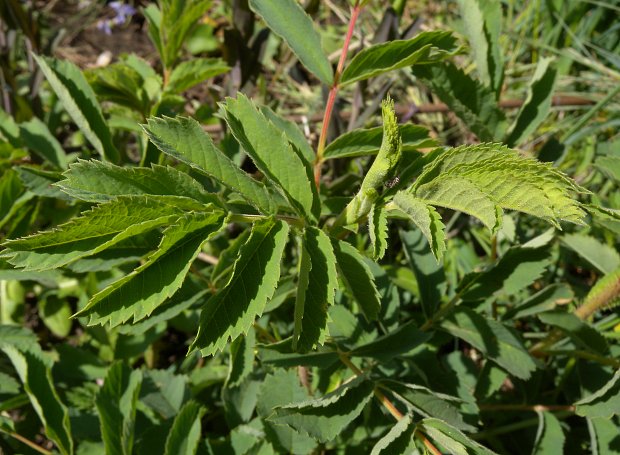
The blooming period occurs from late spring to mid-summer, lasting about 3 weeks. Individual flowers last only a few days and they are fragrant. Afterwards, the flowers are replaced by rose hips that are up to ½" across, globoid in shape, glabrous, and bright red at maturity during the late summer or fall. The fleshy interior of each rose hip is rather dry and contains several seeds. At the tip of each rose hip, there persists 5 dried sepals; these sepals are widely spreading. The chunky seeds are about 4 mm. in length. The root system is woody, branching, and rather deep. Sometimes small clonal colonies of plants are produced from underground runners.
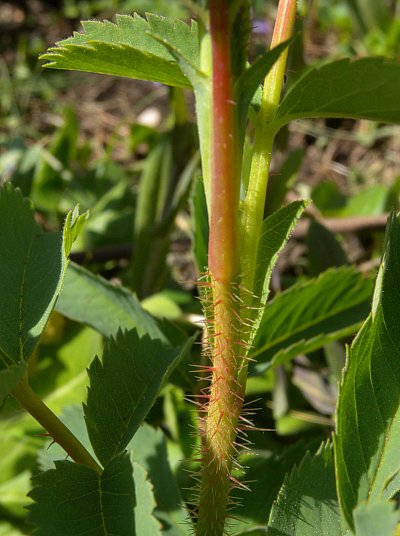
Cultivation: The preference is full or partial sun, mesic to dry conditions, and a somewhat barren soil that contains clay, rocky material, or sand. The hard seeds are difficult to germinate and can lie dormant in the ground for many years. However, once individual plants become established, they are easy to manage. Drought-resistance is excellent.
Range & Habitat: The native Prairie Rose occurs occasionally in northern Illinois and scattered counties elsewhere within the state (see Distribution Map). Illinois lies near the western range limit of this species in North America. Habitats include upland prairies, hill prairies, limestone glades, roadside embankments, areas along railroads, pastures, abandoned fields, and fence rows. This small shrub tends to increase in response to light or moderate grazing from cattle and other mammalian herbivores. This shrub is also well-adapted to occasional wildfires, as it is able to regenerate from its deep root system.
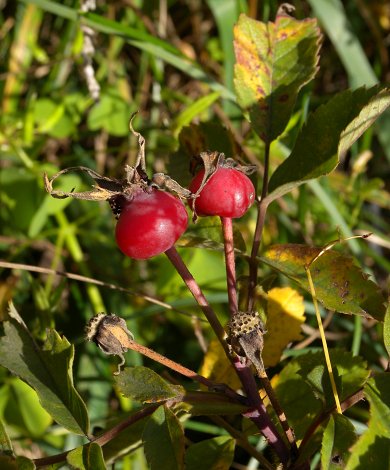
Faunal Associations: The flowers offer only pollen as a reward to visiting insects. These floral visitors include bumblebees and other long-tongued bees, Halictid bees, Andrenine bees, various beetles, and Syrphid flies. The Syrphid flies are too small to effectively cross-pollinate the flowers. An oligolectic bee, Synhalonia rosae, is a specialist pollinator of Rosa spp. (roses). Many kinds of insects also feed on the foliage, stems, and other parts of roses. These insect feeders include grasshoppers, thrips, plant bugs, aphids, leafhoppers, larvae of gall flies, larvae of gall wasps, weevils, flea beetles, larvae of wood-boring beetles, larvae of sawflies, and caterpillars of moths. Some examples of these insects include Heterothrips analis (Wild Rose Thrips), Dasineura rhodophaga (Rose Midge), Rhagoletis basiolum (Rose Hip Maggot), Typhlocyba rosae (Rose Leafhopper), Acyrthosiphon dirhoda (Rose-Grass Aphid), Merhynchites bicolor (Rose Curculio), Altica rosae (Rose Flea Beetle), Macrodactylus subspinosa (Rose Chafer), Allantus cinctus (Curled Rose Sawfly), and Parasa indetermina (Stinging Rose Caterpillar). Among vertebrate animals, the Greater Prairie Chicken and Bobwhite Quail feed on the rose hips, while the Cottontail Rabbit and White-Tailed Deer feed on the foliage (and sometimes the rose hips). When the rose hips are eaten by these animals, the seeds of Prairie Rose are carried to new locations where they can germinate. This is because the hard coats of the seeds enable them to survive passage through the gastrointestinal tract of such animals.
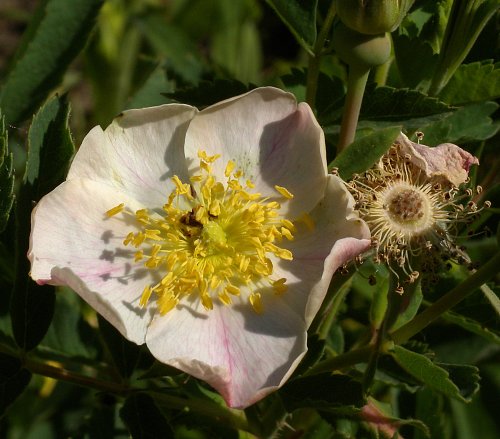
Photographic Location: The wildflower garden of the webmaster in Urbana, Illinois.
Comments: Prairie Rose is one of several rose species (Rosa spp.) in Illinois. This dwarf shrub has surprisingly large and showy flowers that can occur in various shades of pink, depending on the local ecotype. Prairie Rose is similar in appearance and size to the native Pasture Rose (Rosa carolina), but it differs from the latter species in the following ways: 1) its flowering stalks and ovaries are hairless, rather than glandular-hairy, 2) the sepals of its rose hips are usually more persistent, 3) its stems are more densely covered with straight fine prickles, 4) its flowers are more often produced in groups of 2-4, rather than individually, 5) its compound leaves tend to have more leaflets (usually 9). There are two varieties of the Prairie Rose, of which only Rosa arkansana suffulta is native to Illinois. The typical variety, Rosa arkansana arkansana, differs by having leaflet undersides that are hairless. This latter variety occurs rarely within the state as an adventive plant from the west. Unlike most authorities, Mohlenbrock (2002) prefers to classify Rosa arkansana suffulta as a distinct species, Rosa suffulta. Another common of this shrub is the Sunshine Rose.